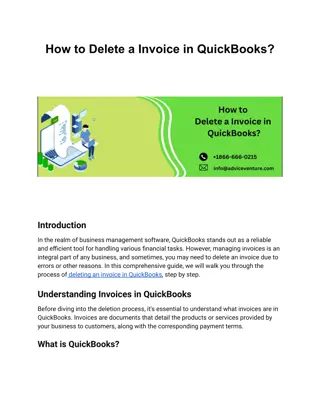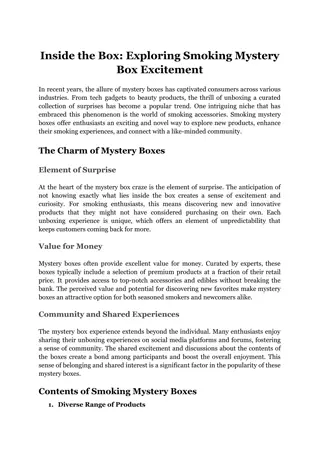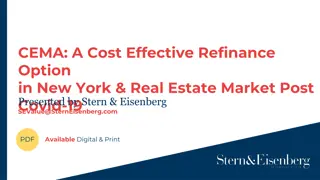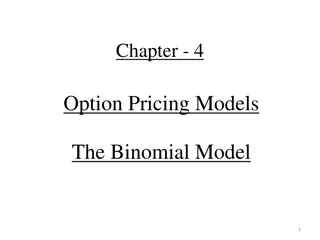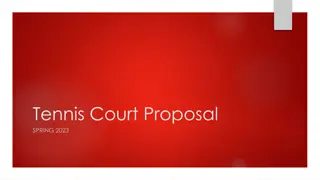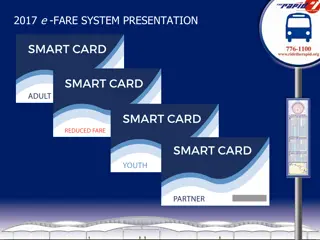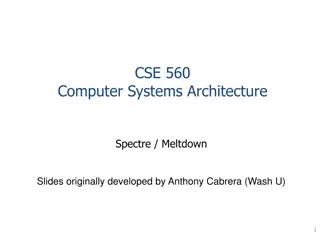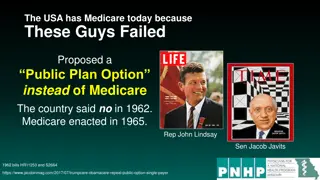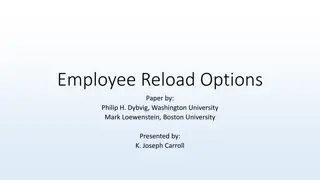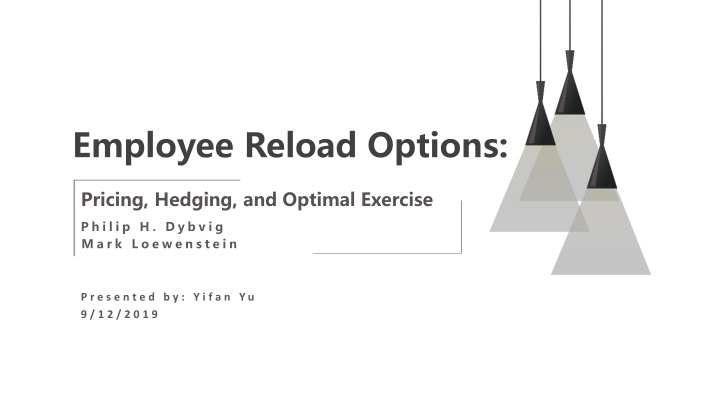
Employee Reload Options: Pricing, Hedging, and Optimal Exercise
Explore the valuation and implications of reload options in compensation schemes, shedding light on their complexities and impact on employee incentives and risk management.
Download Presentation

Please find below an Image/Link to download the presentation.
The content on the website is provided AS IS for your information and personal use only. It may not be sold, licensed, or shared on other websites without obtaining consent from the author. If you encounter any issues during the download, it is possible that the publisher has removed the file from their server.
You are allowed to download the files provided on this website for personal or commercial use, subject to the condition that they are used lawfully. All files are the property of their respective owners.
The content on the website is provided AS IS for your information and personal use only. It may not be sold, licensed, or shared on other websites without obtaining consent from the author.
E N D
Presentation Transcript
Employee Reload Options: Pricing, Hedging, and Optimal Exercise P h i l i p H . D y b v i g M a r k L o e w e n s t e i n P r e s e n t e d b y : Y i f a n Yu 9 / 1 2 / 2 0 1 9
01 / Introduction & Motivation 02 / Valuation of Reload Options 03 / Black-Scholes Case With Dividends CONTENTS 04 / Time Vesting 05 / Conclusion and My thoughts
Introduction & Motivation 1 PART ONE
Introduction & Motivation ADD R E L AT E D T I TLE W O R DS Reload options, sometimes referred to as restoration or replacement options, have been an increasingly common form of compensation for executives and other employees. Reload options are essentially American call options with an additional bonus for the holder. When exercising a reload option with a strike price of K when the stock price is S, the holder receives one share of stock in exchange for K. In addition, when the strike price is paid using shares valued at the current market price (K/S shares per option), the holder also receives for each share tendered a new reload option of the same maturity, but with a strike equal to the stock price at the time of tender. Introduction For example, if an employee owns 100 reload options with a strike of $100 and the stock price at time of exercise is $125, 80 shares of stock with a total market value of $125 x 80 = $10,000 are required to pay the strike price of $10,000 = $100 per option x 100 options. Assuming frictionless buying and selling or at least pre-existence of shares needed to tender in the employee's portfolio, the exercise will net 20 (= 100 - 80) shares of stock with market value of $2,500 (= $125 per share x 20 shares), and in addition the employee will receive 80 new reload options (one for each share tendered), each having a strike price of $125 and the same maturity as the original reload options.
Introduction & Motivation ADD R E L AT E D T I TLE W O R DS The valuation of options in compensation schemes is important for several reasons. Valuations are needed for preparing accounting statements and tax returns, and more generally for understanding what value has been promised to the employees and what residual value remains with the shareholders. Furthermore, understanding the hedge ratios and the overall shape of the valuation function clarifies the employee's risk exposure and incentives. There are some sensational claims about how bad reload options are have appeared in the press. For example, there is a suggestion that being able to exercise again and again and get new options represents some kind of money pump, or that this means that the company is no longer in control of the number of shares issued. Another suggestion in the press is that the reload options might create bad incentives for risk taking or for reducing dividends. The valuation of the reload options will be helpful to assess these claims. Motivation
Valuation of Reload Options 2 PART TWO
Valuation of Reload Options ADD R E L AT E D T I TLE W O R DS The upper bound on a reload option is the underlying stock price, no matter how many reloads are possible and no matter how long the maturity of the option, even if it is infinitely lived. Upper Bound The first exercise (say at price ?1) yields the employee, for each reload option, (1 - K/ ?1) shares and K/ ?1new reload options with strike ?1. At the second exercise (say at price ?2), the employee nets an additional (K/ ?1)(1 - ?1/ ?2) shares, for a total of (1 - K/ ?1) + (K/ ?1)(1 - ?1/ ?2) = (1 - K/ ?2) shares from both exercises, and (K/ ?1)(?1/ ?2) = K/ ?2new options with strike ?2. After the ith exercise, the employee will have in total (1 - K/ ??) shares and K/ ??new options with strike ??. Therefore, no matter how far the stock price rises, the employee will always have less than one share per initial reload option, and the value is further reduced because the employee will not receive the early dividends on all of the shares. The useful lower bound on a reload option's value is the value of an American call option. The reload option can be worth no less because the holder can obtain the American call's payoff by following the American call's optimal exercise strategy without ever exercising the reloaded options. Lower Bound
Reload Options With Discrete Exercise Valuation of Reload Options ADD R E L AT E D T I TLE W O R DS Assumption 1 Assumption 4 The additional shares. employee is always free to hold The dividend payments are nonnegative and the stock price is strictly positive. The employee prefers more consumption to less and can eventually convert dividend payments and share receipts into desirable subsequent consumption. Assumption 5 Assumption 2 There are no taxes or transaction costs. The employee is always holding enough shares to pay the exercise price (or at least can borrow the necessary shares). Most of these assumptions are quite weak and allow for the possibility that the employee may face restrictions on the selling of shares of the stock. The assumption of no taxes is a strong assumption, but without this assumption we cannot say much. For example, it may be optimal to defer exercise into a new tax year to delay recording of income. We think it is plausible that this will not affect the market value by very much, but this remains to be proven Assumption 3 The exercise decision itself does not affect the employee's compensation, the stock price, or dividend payments, for example, through the dependence of future wages on exercise, through a dilution of shares, or through signaling.
Reload Options With Discrete Exercise Valuation of Reload Options ADD R E L AT E D T I TLE W O R DS We assume that exercise is available only on the set of nonstochastic times {?1, ?2, , ??}, where 0 = ?1< ?2< < ??= T. An exercise policy is defined to be an increasing family of stopping times, ??taking values on the grid with ?1< ?1< < ??< . since the strike price is initially K and later is the price of the most recent exercise. In general, after the ith exercise, the employee will have received (1 - K/S(??)) cumulative shares and will hold K/S(??) new reload options with strike price S(??). At a general time t, the employee has received 1- cumulative shares and holds (1) ? ?(?) ? ?(?)reload options with price ?(?), where ? is the strike or exercise price process defined by
Reload Options With Discrete Exercise Valuation of Reload Options ADD R E L AT E D T I TLE W O R DS Proof First we show that X*(t) is as claimed if we exercise at exactly those grid dates when the option is in the money. ? ? ?1 ?2 ?3 Next, we need to show that this is an optimal strategy for the employee. Fix any feasible exercise policy X(t) along with associated managerial, consumption, and portfolio choice decisions, and let ?(?) be the process representing the number of shares of the stock held at time t. Consider switching from X(t) to our candidate optimum X*(t), holding all other decisions fixed outside of the exercise decision. Notice X*(t) X(t). The process ?*(t) which describes the number of shares held at time t is given by The switch is feasible since, by Assumption 1, the employee can always increase the holding of shares, and by Assumption 2, the employee always has enough shares to pay the exercise price. The shift in exercise strategy does not affect the dividend payments, stock price, outside consumption, or portfolio payoffs by Assumption 3 and results in an additional cumulative dividend payment and additional shares. The X*(t) strategy is at least as good as X(t) since by Assumption 4 the employee can eventually convert extra shares into desirable consumption.
Reload Options With Discrete Exercise Valuation of Reload Options ADD R E L AT E D T I TLE W O R DS Under the optimal exercise policy, the market value is: (4) (2) On the other hand, for valuation and hedging, it is more useful to treat each exercise as a cash event. In other words, upon granting shares, the firm values them at the market price. This perspective gives us the alternative valuation formula for an arbitrary exercise policy X(t), (5) Proof Equations (2) and (3) have the same value. Set X(t) = ??(t). On date ??when there is no exercise, ??(t) - ??(t-) = 0 and consequently the jth term in Equation (5) is 0. The other dates are exercise dates, and the term in Equation (5) equals corresponding term in equation (3). (3)
Reload Options With Continuous Exercise Valuation of Reload Options ADD R E L AT E D T I TLE W O R DS When the employee can exercise the reload option continuously, there is a technical issue of how to define payoffs. We finesse these technical issues on a continuous set of times as a suitable limit of exercise on a discrete grid as the grid gets finer and finer. At this point we add the assumption that any jumps in the process S are downward jumps, that is, S(t) - S(t-) < 0. This assumption implies that M is continuous: M can only jump up where S does and S cannot, while M is a cumulative maximum and therefore cannot jump down. It is nice that the assumption we need is also exactly the assumption that accommodates predictable dividend dates (which are times when the stock price can jump down), provided reinvesting dividends results in a continuous wealth process. The strike price process: The value: which is the formula that will allow us to derive a simple expression Black-Scholes case with dividends. Which is the same as Equation (2) except with the continuous process M substituted for ??. Cash Event:
Black-Scholes Case With Dividends 3 PART THREE
Black-Scholes Case With Dividends ADD R E L AT E D T I TLE W O R DS (6)-(8) We assume a constant positive interest rate r, so bond prices follow (6) (9) With the Black-Scholes assumption of a constant volatility per unit time and continuous proportional dividends, the stock price and cumulative dividend processes follow (10) (7) (8) (11) (11)
Comparison ADD R E L AT E D T I TLE W O R DS Figures 1 and 2 compare the reload option values and hedge ratios to those for a European call option as a function of moneyness. These figures confirm that the reload option value is less than the stock price and the hedge ratio is less than or equal to one. While the reload option is generally more valuable than the European call option, the general incentive effects are quite similar. One measure of the incentive effects of option compensation is the delta per unit value of the option. Figure 3 plots this measure versus moneyness for reload and European call options. In these terms, we see that the incentive effects of the reload option are quite similar to those of a European call option with the same market value.
Comparison ADD R E L AT E D T I TLE W O R DS Figures 4 and 5 show values of reload options for various parameters, while Figures 6 and 7 compare the values of the reload option to those of a European call option. These figures confirm that the reload option value is increasing in ? and decreasing in ?. From Figure 6 we see that the reload option value for a non-dividend-paying stock is quite close to that of the European call option for low volatility, but as the volatility increases, there is a widening spread between the reload option value and the European call value. For volatilities much larger than are shown, the two must con- verge again, since both converge to the stock price as volatility increases. In Figure 7 we see that for a dividend- paying stock, the reload option value is uniformly higher than the European call option, as would be the value of an American call option. Figure 8 shows the gamma (the second derivative of the value with respect to stock price) for the reload and European call options as a function of S/K. Here we clearly see gamma is discontinuous at the money, just as an ordinary American option has a discontinuous gamma at the optimal exercise boundary.
Time Vesting 4 PART FOUR
Time Vesting ADD R E L AT E D T I TLE W O R DS In many cases the employee is prohibited from exercising the reload option until the end of an initial vesting period. Typically the reload options received after the initial exercise are also subject to the same vesting period. 1 A useful upper bound is the value we have obtained for continuous exercise. A useful lower bound-and also a useful approximation to the value-is the value we have obtained for discrete exercise, provided that the time interval between adjacent dates ?? 1and ??is (except perhaps the first interval) equal to the vesting period. For example, if the vesting period is 6 months and we are 20 months from maturity, we assume we can exercise the option 2, 8, 14, and 20 months from now. Time Vesting 2 Although we know that always exercising when in the money at multiples of the vesting period is not optimal, the quality of the approximation shows that it is nearly optimal. 3
Conclusion and My thoughts 5 PART FIVE
Conclusion and My thoughts ADD R E L AT E D T I TLE W O R DS The results shed light on some of the controversy about reload options. For example, the observation of the upper bound of the reload option debunks effectively the popular claim that not having a limit on the number of reloads or the overall maturity means that the company is losing control of how many options or shares can be generated. On the other hand, if not many exercises and the reload option is out of the money, then the portfolio of shares plus options has a hedge ratio and gamma similar to a European call option. In sum, the reload option seems similar to a hybrid of a share grant and a European call option. It is an optimal to exercise the reload option whenever it is in the money. In principle it is hard to assess the incentive effects of different compensation packages. However, as a first approximation we can look at the value, hedge ratio, and gamma of the reload option and compare those to those for a European call option. Figures 1, 2, 3, and 8 suggest that in terms of these measures, a reload option is quite similar to a European call. However, we should also consider the dynamic nature of the reload package. As higher stock prices are attained, the reload option holdings decrease as more exercises occur. The hedge ratio and gamma of the portfolio behave more like a share and less like an option. In my opinion, this is an excellent paper which clearly introduces the features of the reload option, and have given a scientific basis for valuation of the options. One thing I am curious about is how should the firm decide which kind of compensation package is the best to use as the incentive for employees.





